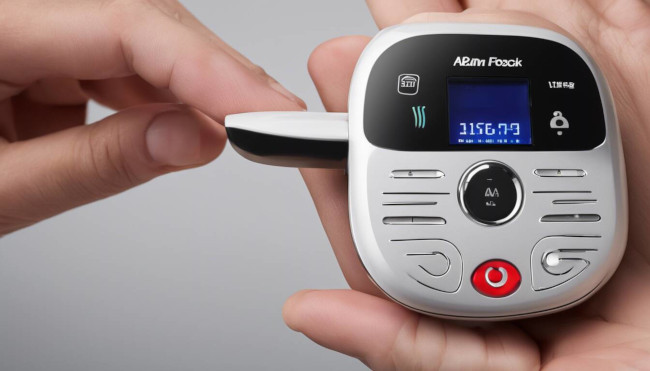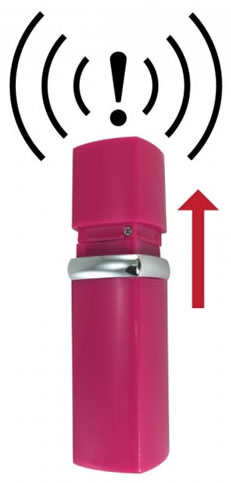How to Use a Personal Alarm

Utilizing a personal alarm is as simple as carrying it on your person, ready to activate at a moment's notice in an emergency situation. When triggered, these nifty devices emit an alarm - usually ranging from 100 to 140 decibels - loud enough to get the attention of passersby and throw off potential threats. It might just be less intimidating than one might expect – there’s no advanced tech knowledge needed, just a good understanding of when to sound it. Alertness is your best friend. Now, let's dive deeper into the nature of this lifesaver.
To use a personal alarm, simply carry it with you and activate it by pressing the button or pulling the pin in an emergency situation. The loud sound emitted will attract attention and potentially deter an attacker, providing you with an opportunity to escape and seek help.
What is One and How Does it Work?
A personal alarm is akin to having an extra set of eyes or ears when you need them most. It's designed to be your instant call for help in moments of distress, creating a powerful sound to attract attention and deter potential threats. Think of it as a force field—instead of keeping things out, it draws attention directly to you in times when you may not be able to call for help yourself.
The way these small devices work is quite remarkable. When activated, a personal alarm emits a high-decibel sound, often ranging from 100 to 140 decibels. To put this into perspective, 120 decibels is equivalent to standing next to an active chainsaw. This intense noise is carefully calibrated to disorient an attacker while simultaneously drawing the attention of those nearby. As soon as the alarm is triggered, most assailants typically don't expect such a sudden burst of sound. This can startle them and cause them to hesitate or move away from the source of the sound, buying you time to escape or seek help.
Personal alarms are highly portable and conveniently come in various forms such as keychain attachments, wristbands, or standalone units. These forms allow them to be carried discreetly and used quickly without any fumbling around. In essence, these small but mighty tools can turn the tables in your favor during moments of vulnerability. They act as a deterrent and a beacon—drawing attention and help when you need it most.
Now that we've grasped the workings and importance of personal alarms, let's explore how to effectively use them in different scenarios for your safety and self-defense.
Safety Benefits of Using a Personal Alarm
One of the most immediate benefits of carrying a personal alarm is its deterrent effect. The loud, piercing sound emitted by a personal alarm can startle and surprise potential attackers, often causing them to flee the scene. This sudden noise also serves as an alert to people nearby that something is amiss, drawing attention to the situation and increasing the likelihood of intervention. It's comparable to a car alarm going off in a parking lot - it immediately captures attention and encourages individuals to investigate further.
In the event of an emergency, whether it's an assault or any other threatening situation, time becomes a critical factor. When activated, a personal alarm enables rapid alerting of assistance from nearby individuals, law enforcement, or other first responders. The swift response to the alarming sound can lead to intervention and potentially prevent an incident from escalating further. This quick summoning of aid can be especially crucial in scenarios where direct intervention could make a substantive difference.
Consider someone being followed down a dimly lit street and feeling unsafe. Activating the personal alarm could bring help swiftly and effectively, potentially discouraging further pursuit and ensuring their safety.
Moreover, the psychological impact should not be underestimated. For many individuals, especially those who are vulnerable or regularly face a heightened risk of confrontation, carrying a personal alarm provides a profound sense of security and empowerment. Even if the alarm is never actually used in an emergency, its mere presence offers peace of mind and confidence in facing day-to-day challenges.
Carrying a personal alarm can provide a sense of security and empowerment, especially for individuals who are vulnerable or face a heightened risk of confrontation.
In essence, the safety benefits extend beyond just deterring physical harm; they encompass a broader scope of protection that includes psychological well-being and peace of mind. These devices offer more than just an alarm; they deliver assurance and the potential for immediate help when it matters most.
As we've seen, personal alarms serve as versatile tools that contribute not only to physical safety but also to psychological well-being. Now let's explore how to maximize their effectiveness by considering the best places to store and carry a personal alarm.
Best Places to Store and Carry a Personal Alarm

Where you choose to keep your personal alarm can significantly impact its effectiveness when you need it. Let's review some recommended spots to store and carry a personal alarm, ensuring that you're always prepared for any situation.
Keychain
Attaching your personal alarm to your keychain is one of the most convenient options. Consider this—your keys are typically within reach, especially when you're on the move. By including your personal alarm on your keychain, it's easily accessible at all times. This makes it quick to grab in case of an emergency. Moreover, having it on your keychain provides a reassuring sense of security, knowing that you're equipped with a safety device everywhere you go.
Bag or Purse
Clip-On Personal Alarm
For those who prefer a subtle approach, keeping the personal alarm in a bag or purse is a prudent choice. This method keeps the alarm secure while granting easy access without drawing attention to it. Picture being in a crowded area and feeling uneasy—having your personal alarm in your bag or purse lets you reach for it without causing any commotion. It's an inconspicuous way to have access to an essential safety tool.
Wrist or Arm Strap
Wearing the personal alarm on a wrist or arm strap is a popular choice for individuals seeking hands-free options. Whether you're going for a jog, walking the dog, or simply running errands, attaching the personal alarm to your wrist or arm offers both convenience and swift activation. In situations where you may need to use your hands for other tasks, such as holding onto groceries or operating your phone, having the personal alarm within reach but out of the way on a wrist or arm strap can be invaluable.
By storing and carrying your personal alarm in these recommended places, you're ensuring that it's readily available when you need it most. Each option has its unique benefits, from accessibility to discretion, allowing you to choose what works best for your lifestyle and comfort.
With an understanding of the ideal storage methods covered, our next step is to explore how to effectively utilize a personal alarm in various emergency situations.
Activate: Using the Keychain, Pull Pin, and Press Button Methods
When it comes to activating your personal alarm, knowing the different methods is crucial for quick and effective use during an emergency. Each method has its own unique features and advantages, so let's take a closer look at each one.
Keychain Activation
For keychain personal alarms, pulling a pin or separating a keychain attachment activates the alarm, causing it to emit a loud sound.
The keychain activation method is convenient and often allows for easy access. By pulling the pin or removing the attachment, you can swiftly activate the alarm. This feature makes it ideal for carrying on your keys or attaching to a bag, ensuring that you have quick access to the alarm when needed. Additionally, this method provides an added layer of security, as an assailant trying to grab your personal belongings may inadvertently trigger the alarm.
Pull Pin Method
Some personal alarms have a pin that, when pulled, triggers the alarm, functioning similarly to a grenade pin.
The pull pin method is straightforward and intuitive. It mirrors the design of safety devices like fire extinguishers and emergency exit alarms, making it easy for anyone to understand and use in a high-pressure situation. The physical act of pulling the pin can also serve as a clear signal for those nearby that you are in distress and require assistance.
Press Button Activation
Other models feature a button that, when pressed, sets off the alarm, providing a simple and speedy activation process.
The button activation method is designed for immediate action. By pressing a button, you can swiftly activate the alarm without any additional steps, making it an efficient choice in urgent situations. This method is ideal for individuals who prioritize speed and simplicity when using their personal alarm.
With these different activation methods in mind, it's important to choose a personal alarm that aligns with your lifestyle and preference for ease of use during an emergency. Each method offers unique benefits, ensuring that you can quickly activate your alarm when every second counts.
Recommended Features
Choosing a personal alarm can be overwhelming with the multitude of options available, but certain features are essential to consider as they can significantly impact your safety and ease of use. Let's take a closer look at three crucial features to prioritize when selecting a personal alarm.
Loud Decibel Level
When it comes to personal alarms, one of the most critical features is the loudness. Look for an alarm with a high-decibel output, ideally producing at least 120 decibels. This level of sound can be heard from hundreds of feet away, maximizing deterrence and immediately drawing attention to your distress, potentially deterring an attacker.
The purpose is not just to startle an attacker, but also to alert people nearby about potential danger. A loud and piercing sound is more likely to attract attention compared to a quieter alarm. It's akin to having a virtual group of allies come running toward you in response to the sudden alarming noise.
Compact and Discreet Design
Opt for a compact, easily concealable design that can be conveniently carried in your pocket or worn around your wrist or neck without drawing unnecessary attention when not in use. An inconspicuous design offers peace of mind, knowing that you have protection within reach without advertising this fact to everyone around you.

An inconspicuous design can be an advantage in situations where you don't want others to know you're equipped with a safety device. It offers peace of mind knowing that you have protection within reach without advertising this fact to everyone around you.
Reliable Activation Mechanism
Ensure that the personal alarm has an intuitive and quick activation method, such as simple push-button activation or effortless pull-pin mechanisms for immediate and effective response during emergencies. A reliable activation mechanism provides peace of mind by ensuring that you can trigger the alarm swiftly and efficiently when faced with danger.
In stressful situations, every second counts, so the last thing you want is to fumble around trying to figure out how to activate your alarm. A reliable activation mechanism provides peace of mind by ensuring that you can trigger the alarm swiftly and efficiently when faced with danger.
By considering these key features – loud decibel level, compact and discreet design, and reliable activation mechanism – when choosing a personal alarm, you can enhance your safety preparedness with a reliable and effective tool for self-defense.
Effectiveness of Personal Alarms for Self-Defense
Panic Alarm Sounds 130db Noise to Deter Attacks
When it comes to self-defense, having a personal alarm can be a game-changer. These small devices have a big impact on safety. Imagine you're in a situation where someone is threatening you or making you feel scared. You don't want to fight them, but you need help. That's when a personal alarm comes in handy.
Drawing Attention: Most personal alarms are designed to make a loud, piercing sound when activated. This abrupt noise is often enough to startle an attacker by drawing attention to the situation. Just like how a loud siren from an ambulance makes drivers aware and pull over, personal alarms are an auditory lifeline, signaling for help without the need for direct confrontation.
Non-Violent Deterrence: In situations where physical conflict might not be an option or isn't the best choice, a personal alarm offers a non-violent means to discourage unwanted advances and protect oneself. Consider scenarios such as traveling alone, walking through unfamiliar areas, or navigating parking garages after dark; personal alarms offer reassurance and confidence in these situations where physical defense may not be viable.
Signaling for Help: Sometimes, all you need is a way to call for help without putting yourself in danger. Personal alarms serve as an audible distress signal that can reach out for assistance from those nearby. By creating a noticeable commotion and alerting others to your predicament, personal alarms open up opportunities for prompt and effective intervention by law enforcement or other authorities.
In essence, personal alarms are essential tools for maintaining personal safety and security in diverse environments. As with any self-defense measure, having one doesn't guarantee complete protection, but it significantly increases one's ability to respond effectively in threatening situations without resorting to violence.
Understanding the effectiveness of personal alarms underscores their role as valuable assets for ongoing safety and security. Their non-violent nature makes them particularly valuable when direct physical confrontation isn't viable or desired, giving individuals an extra layer of protection wherever they go.
Effectively integrating personal alarms into your safety routine enhances your ability to navigate potentially dangerous situations with confidence and assurance.
Add your comment now!
Post Comment


